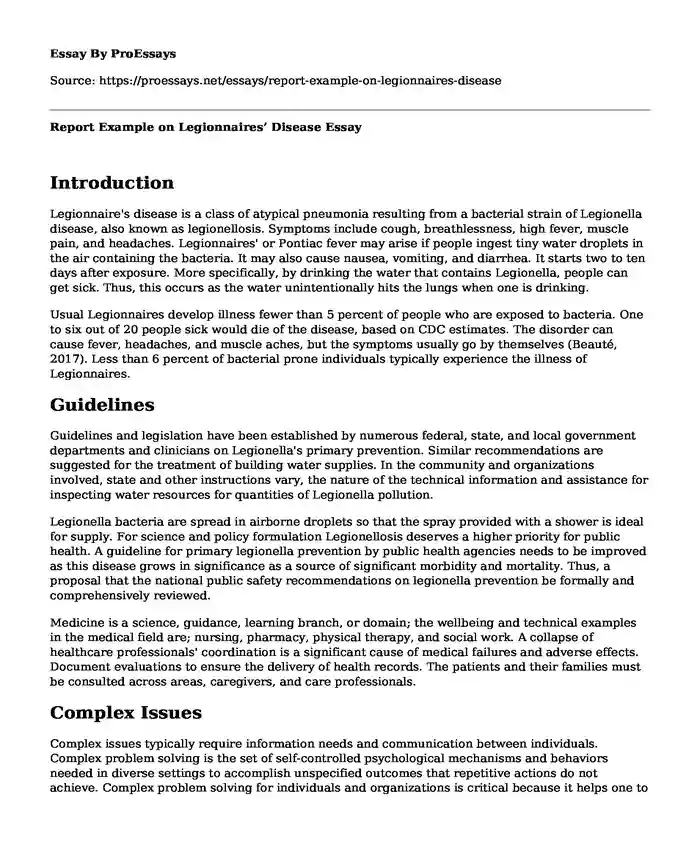Introduction
Legionnaire's disease is a class of atypical pneumonia resulting from a bacterial strain of Legionella disease, also known as legionellosis. Symptoms include cough, breathlessness, high fever, muscle pain, and headaches. Legionnaires' or Pontiac fever may arise if people ingest tiny water droplets in the air containing the bacteria. It may also cause nausea, vomiting, and diarrhea. It starts two to ten days after exposure. More specifically, by drinking the water that contains Legionella, people can get sick. Thus, this occurs as the water unintentionally hits the lungs when one is drinking.
Usual Legionnaires develop illness fewer than 5 percent of people who are exposed to bacteria. One to six out of 20 people sick would die of the disease, based on CDC estimates. The disorder can cause fever, headaches, and muscle aches, but the symptoms usually go by themselves (Beauté, 2017). Less than 6 percent of bacterial prone individuals typically experience the illness of Legionnaires.
Guidelines
Guidelines and legislation have been established by numerous federal, state, and local government departments and clinicians on Legionella's primary prevention. Similar recommendations are suggested for the treatment of building water supplies. In the community and organizations involved, state and other instructions vary, the nature of the technical information and assistance for inspecting water resources for quantities of Legionella pollution.
Legionella bacteria are spread in airborne droplets so that the spray provided with a shower is ideal for supply. For science and policy formulation Legionellosis deserves a higher priority for public health. A guideline for primary legionella prevention by public health agencies needs to be improved as this disease grows in significance as a source of significant morbidity and mortality. Thus, a proposal that the national public safety recommendations on legionella prevention be formally and comprehensively reviewed.
Medicine is a science, guidance, learning branch, or domain; the wellbeing and technical examples in the medical field are; nursing, pharmacy, physical therapy, and social work. A collapse of healthcare professionals' coordination is a significant cause of medical failures and adverse effects. Document evaluations to ensure the delivery of health records. The patients and their families must be consulted across areas, caregivers, and care professionals.
Complex Issues
Complex issues typically require information needs and communication between individuals. Complex problem solving is the set of self-controlled psychological mechanisms and behaviors needed in diverse settings to accomplish unspecified outcomes that repetitive actions do not achieve. Complex problem solving for individuals and organizations is critical because it helps one to manage our world. The solution to the issues offers a system in which these structures can be defined; they are broken, and the path to repair them is decided.
The solution to this complex problem was effective. Many antibiotics against Legionella bacteria are highly successful. Macrolides and quinolones are the two most effective classes of antibiotics. Ensuring that constructing owners and administrators hold building aqua distributions helps to minimize the menace of Legionella. Such developments and expansions are the secrets of avoiding legionnaires' diseases (Cunha, Burillo & Bouza, 2016). Legionella may expand and spread in areas such as the building systems for water, hot tubes, hot tubs, tanks, and heaters for hot water.
Stream attributes and wells should be washed regularly. Maintaining the water supply is the most effective way to stop the outbreak of Legionnaires. The Legionella bacteria, therefore, can not develop and expand. Water services should then be tested daily and disinfected, if necessary.
Interdisciplinary Approach
An interdisciplinary approach includes team members from multiple backgrounds that work for the same objective. A multidisciplinary approach consists of the individual creation of institutional treatment programs. It requires cooperating but not specifically looking at its relationship. The health care staff must collaborate using an interdisciplinary approach to provide a clinical strategy that addresses the patient's expectations and needs and brings it into effect. Both health staff has a common position in delivering elderly individually based services.
An interdisciplinary approach is focused on the cooperation between health providers and the patient from various backgrounds. The best teams share tasks and foster interdependence of functions. Make sure team members recognize their typical duties and obligations in the team system and have specific priorities. Recognize the overlap in information and knowledge among workers from diverse sectors.
Successful comprehensive and organized therapy based on patient needs will help minimize complications in completing medication and replicating the evaluation. The patient's participation in all facets of their treatment allows them to talk and make a decision (Hamilton et al., 2018). They were preparing structured interdisciplinary care schemes and medical reports that lead to patients' full and holistic treatment.
Conclusion
The elderly also have a multitude of diagnoses and complex conditions in hospitals. A growing number of older people continue to be cared for interdisciplinarily. It can help solve complex emotional, psychiatric, and multimorbidity challenges. An interdisciplinary approach will enhance performance, clinical practices, and comfort levels for patients. For patients, families, and providers to establish their new strategy, the capacity for dialogue provided by interdisciplinary care preparation should be used.
References
Beauté, J. (2017). Legionnaires’ disease in Europe, 2011 to 2015. Eurosurveillance, 22(27), 30566.
Cunha, B. A., Burillo, A., & Bouza, E. (2016). Legionnaires' disease. The Lancet, 387(10016), 376-385.
Hamilton, K. A., Prussin, A. J., Ahmed, W., & Haas, C. N. (2018). Outbreaks of Legionnaires’ disease and Pontiac fever 2006–2017. Current environmental health reports, 5(2), 263-271.
Cite this page
Report Example on Legionnaires' Disease. (2024, Jan 01). Retrieved from https://proessays.net/essays/report-example-on-legionnaires-disease
If you are the original author of this essay and no longer wish to have it published on the ProEssays website, please click below to request its removal:
- Research Proposal Example: Impact of Medical Procedure Prices on Society
- Nursing Theorists Annotated Bibliography
- The Orientation and Induction Process of Nurses Essay
- Comments on Patient's Results: Acute Pulmonary Edema Paper Example
- Informatics Technology: Revolutionizing Nursing Care & Health Outcomes - Essay Sample
- COVID-19 and African Americans in NYC: Tough Times, Tough Measures - Essay Sample
- Essay Example on Human Circadian Rhythms







